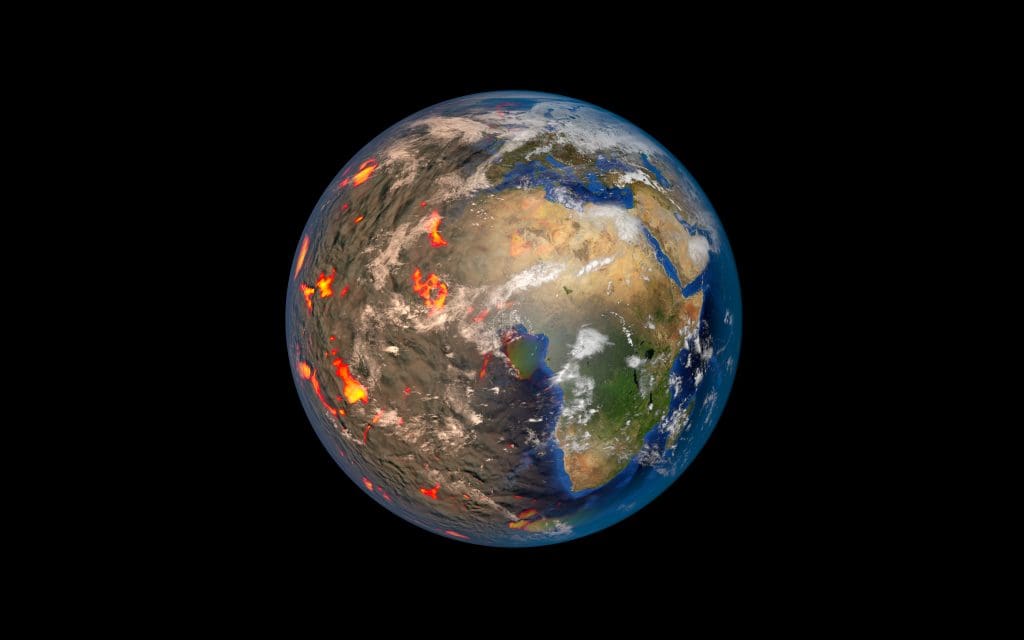What can you do now to mitigate and prevent the health effects of climate breakdown?
- Fossil fuels emits greenhouse gases into the atmosphere, which warms the planet.
- A warmer planet increases risks related to physical and mental health.
- Planetary warming combined with societal inequity result in disastrous impacts of wildfires, extreme temperatures, and severe storms on human health and well-being.
Learning Objectives
- Describe climate breakdown and its effect on chronic health conditions and mental health.
- Discuss the language of urgency developed by climate experts.
- Explain action steps nurses can take to educate patients about health and climate breakdown, impact preparedness for climate disasters, and advocate for climate breakdown mitigation and prevention.
The authors, planners, and peer reviewers of this CNE activity have disclosed no relevant financial relationships with any commercial companies pertaining to this activity. See the last page of the article to learn how to earn CNE credit.
Expiration: 7/1/26
Although most Americans voice concern about climate change (climate breakdown), many remain unaware that they’re experiencing its effects today. In fact, those born in the 1980s or later likely have never experienced “normal weather.” According to the Intergovernmental Panel on Climate Change, for the past 150 years, the planet has been steadily warming, largely as a result of the unrelenting burning of fossil fuels and the emission of greenhouse gases. Climate breakdown can worsen chronic conditions and challenge our emotional health, while leading to more frequent and severe drought, flooding, wildfires, and superstorms, risking health and well-being. (See Language of urgency.)


Language of urgency
To enhance clarity, adhere to scientific accuracy, and raise public awareness, many climate experts have begun using terms such as climate breakdown, emergency, crisis, disruption, catastrophe, and disaster rather than simply climate change.
Enhanced clarity
The term climate breakdown conveys a clearer sense of urgency and the need for immediate action. It describes the severity of the situation more accurately than climate change, which sounds potentially natural. Climate breakdown may help readers understand that were experiencing a rapid and alarming deterioration of our climate system that requires urgent attention.
Scientific accuracy
Many leading climate scientists and researchers now argue that climate change fails to adequately communicate the seriousness of the situation. Scientific consensus indicates that the Earths climate is undergoing profound disruptions, characterized by extreme weather events and escalating environmental risks. By using climate breakdown, we align our language with scientific findings, which supports accuracy and credibility.
Public awareness and engagement
As nurses, were using the term climate breakdown to help raise public awareness and promote active engagement in climate-related issues that profoundly affect our health. By emphasizing the urgency and potential consequences of environmental degradation, we seek to ignite a comparable intensity in the efforts of individuals, communities, and policymakers to take meaningful action. The terminology highlights the crucial need for nurses to advocate for swift policy and practice changes that reduce waste, conserve energy and water, promote sustainable transportation options, and encourage federal, state, and local governments and healthcare systems to rapidly reduce the burning of fossil fuels and the emission of other greenhouse gases.
As the most trusted profession in the United States, nurses play a pivotal role in helping people achieve and maintain good health, even in a warming world. You can use your knowledge about the health impacts of climate breakdown to assess and educate patients and the public. In addition, you can use your powerful voice to advocate for health system and political action to slow climate breakdown and lessen its adverse impact.
Climate breakdown and chronic conditions
Our warming planet drives changes in weather patterns and climate across the globe. These conditions threaten the health of millions of people, especially those with chronic conditions (including respiratory diseases, cardiovascular disease, diabetes, nephropathy, cancer, obesity, and dementia), which includes 80% of adults in the United States over age 65, according to the National Center on Aging.
Climate-related phenomena can worsen respiratory disease, including asthma, allergies, and chronic obstructive pulmonary disease. Warmer temperatures are associated with higher levels of air pollution as dryer conditions generate more dust, increased ground-level ozone and smog, and longer growing seasons, which create more pollen. Deadly wildfires emit smoke that lingers for months, irritating lungs and increasing inflammation. The burning of fossil fuels not only drives climate breakdown, it also creates air pollution that worsens health.
Extreme heat and air pollution can exacerbate cardiovascular disease. Higher temperatures can lower blood pressure and increase arrhythmias, such as tachycardia and atrial fibrillation, as the body attempts to cool itself. Extreme heat can increase blood viscosity and worsen dehydration, raising the risk of heart attack or stroke. Long periods of high temperatures may make it more difficult for people to exercise regularly, leading to poorer underlying health.
Diabetes intersects with climate breakdown in several ways. Metabolic demands in warmer conditions can be more difficult to manage, which may require patients to test their glucose more frequently. Exercise, essential for diabetes management, is riskier during high heat. Dehydration increases during hot conditions, and people with diabetes may be less able to regulate body temperature. Many individuals with diabetes may require additional precautions during extreme weather and disaster events. For example, they may want to prepare an emergency plan and a kit with disease management supplies, snacks to relieve hypoglycemia, water to prevent dehydration, and a list of emergency contacts. They also should consider a back-up plan in case of a power outage to maintain medication and keep equipment running. In addition, insulin becomes less stable at high temperatures, and the availability of testing kits and supplies may be threatened.
According to Glaser and colleagues, the incidence of heat stress nephropathy is increasing. The combination of heat and dehydration stresses kidneys, especially for individuals with risk factors (such as diabetes, heart disease, or a family history of kidney disease) and those who work in outdoor settings. Dehydration, which increases in high temperatures, can lead to painful kidney stones. People undergoing dialysis treatment may experience heat sensitivity, which requires them to stay cool or to cool off quickly. These and all patients need to be aware of the signs of heat exhaustion and heat stroke.
The relationship between climate breakdown and obesity is complex. For example, reduced activity associated with higher temperatures can contribute to weight gain, and obesity contributes to increased use of fossil fuel energy for cooling, transportation, and comfort. Fossil fuel-intensive agriculture depends on plastics, pesticides, and other potentially endocrine-disrupting chemicals, which may interfere with the body’s endocrine function and its ability to maintain a healthy weight. Many individuals with obesity are at higher risk for heat-related illness and may have difficulty cooling.
Patients can experience cancer as an acute or chronic condition. Climate breakdown increases exposure to cancer-causing pollution, such as smog and the release of toxic chemicals from flooding. The same modern diet that worsens climate breakdown may expose individuals to cancer risk. In addition, extreme weather events and climate-related supply disruptions may interfere with cancer care.
Dementia leads to devastating impacts for patients and their caregivers. A 2019 systematic review by Peters and colleagues demonstrates an association between greater exposure to air pollution and increased risk of dementia. Conversely, reducing air pollution may help improve brain function. During high heat events, people with dementia may be less able to care for themselves and are at higher risk of dehydration, injury, and complications.
Action steps
- Learn about health risks of a warming planet for your specific patient population.
- Talk to patients and families about risks to prepare for and avoid. For example, teach them how to reduce their exposure to wildfire smoke and air pollution.
- Teach patients with heart conditions about the warning signs for arrhythmias.
- Provide information about heat stress, exhaustion, and stroke, and about staying cool and hydrated.
- Help to reduce fossil fuel use in healthcare and nursing practice. Advocate for alternatives, reduced overconsumption, and the purchase of environmentally safer products.
Climate breakdown and mental health
Two concepts frequently linked to climate breakdown and mental health are eco-anxiety (a concept linked to psychological responses to climate breakdown, including negative emotions such as fear and anxiety) and solastalgia (defined by Albrecht as “the pain or sickness caused by the loss or lack of solace and the sense of isolation connected to the present state of one’s home and territory.”) An early 2022 review of Google Scholar using “solastalgia” as the search term resulted in 2,730 citations, which reflects the significance of the concept.
Populations at increased mental health risk related to climate breakdown include children, adolescents, and young adults. According to Burke and colleagues, direct and indirect effects of climate breakdown place children at risk for mental health consequences such as depression, anxiety, phobias, and sleep disorders. Other at-risk populations may include those in locations more likely to face severe weather (such as flooding and hurricanes), those diagnosed with mental illness, individuals who experience structural inequities (related to ethnicity or race, gender, education level, financial resources), migrants, the unhoused, and those living with pre-existing disabilities or chronic illnesses.
Climate scientists also are at mental health risk due to their ongoing exposure to mounting climate breakdown data. First responders may have elevated risk for post-traumatic stress disorder and mental health issues as a result of sustained exposure to severe weather linked to climate breakdown.
Climate breakdown can lead to increased feelings of loss, hopelessness and fatalism, and elevated heat may be linked to higher rates of aggression and violence. According to Porteous-Sebouhian, tricyclic antidepressants and antipsychotic medications (such as aripiprazole, risperidone, and haloperidol) may disrupt heat regulation, which is especially problematic during prolonged heat waves.
Action steps
- Encourage patients to acknowledge their feelings and talk about them. Anxiety and fear are perfectly normal responses to climate breakdown, which can seem overwhelming and inevitable. Projects such as Eco-Anxious Stories (facebook.com/ecoanxiousca) provide a venue for sharing experiences and feelings and accessing coping tools.
- Advise patients to regularly connect with neighbors, community organizations, and local leaders to establish relationships that can weave a stronger social network and provide beneficial new perspectives.
- Talk with patients about developing emergency plans. Taking this step will give them an enhanced sense of agency and preparedness.
- Work to raise nurse awareness of the possible impacts of some psychiatric medications on heat regulation and the potential for increased aggressive behavior during heat waves.
- If you work with children and young adults, you can find useful conversational strategies at the Talk Climate website (talkclimate.org/handouts). In addition, join youth in their activism, which can foster feelings of trust.
- Help individual clients increase their sense of personal agency by connecting them with actions that provide a sense of meaning and foster hope, as well as feelings of connectedness to family, culture, place, and community.
Climate disasters
In 2021, according to the The Washington Post, more than 40% of Americans lived in counties that experienced climate disasters, such as storms, wildfires, or flooding. Without action to slow climate breakdown, according to a study by Thiery and colleagues, children born today are expected to face up to seven times more climate disasters over their lifetimes than people born in 1960.
A study published by Hickman and colleagues found that young people feel betrayed by government response to climate breakdown, which contributes to feelings of climate anxiety. For example, in 2015, 21 young people and children brought a case against the government in Juliana v. United States, claiming that the government had infringed on their constitutional right to life, liberty, and property by persisting in permitting, subsidizing, and perpetuating dependence on fossil fuels. They brought the case in response to increased exposure to hazards that climate scientists can now attribute to climate breakdown. One of the plaintiffs, 7-year-old Levi Draheim, had already experienced increasingly severe storms and red algal blooms due to climate breakdown. In a denial of the government’s motion to dismiss the case in 2016, U.S. District Judge for Oregon Ann Aiken declared, “Exercising my ‘reasoned judgment,’ I have no doubt that the right to a climate system capable of sustaining human life is fundamental to a free and ordered society.” Levi and his family have since had to leave their home and many of the other children are now adults, but the case remains unresolved because of continued interference by the government to prevent it from going to trial.
The direct impacts of the hazards from climate breakdown frequently are accompanied by indirect hazards, including damage to infrastructure, such as mold in homes after flooding, power outages during a heat wave or a storm, or saltwater intrusion into the water supply from rising sea levels. Climate hazards can interact with each other, resulting in compounding effects, including heightened risk of landslides during an extreme rain event in areas scarred by wildfire, and lack of water to fight a wildfire due to prolonged drought. Social and political systems that distribute risk inequitably worsen these impacts. Many people face greater risk of poor health outcomes just because of where they live. For example, in 2021, torrential rain associated with Hurricane Ida quickly flooded basement apartments in New York City, drowning residents. For many low-income people, these basement apartments are the only affordable place to live.
Also in 2021, multiple heat waves with three-digit temperatures across the United States led to hospitalizations and deaths. Many people without air conditioning were forced to open their windows to cool off, only to breathe smokey air, an exposure that can result in hospitalization or death for those with underlying chronic disease. Others experienced acute forms of energy insecurity, including loss of power due to melting transformers or other infrastructure damage. A loss of power cuts off access to water pumps, temperature controls, fans, refrigeration, and durable medical equipment (such as oxygen concentrators) when they’re needed the most.
Nurses may be called upon to help patients evacuate and then respond to the surge of patients in care settings. You can promote preparedness by evaluating the emergency readiness of your local community and your care setting. Contact your local emergency management office and ask for educational resources, participate in emergency drills, and develop systems to ensure that all home health and discharged patients have emergency plans and medication lists. In addition, educate patients about securing back-up batteries or oxygen tanks, provide a checklist of go-bag items in case of evacuation, and connect patients with organizations that can visit homes during an emergency. Collaborate with other disciplines in your workplace and ensure that they have up-to-date knowledge on the local assistance available to people who rely on electricity-dependent medical equipment.
Action steps
- Share personal and patient stories about living through climate disasters when advocating at local, state, and national levels for a rapid transition away from fossil fuels.
- Connect with local mutual aid groups and take steps to increase the emergency preparedness of your workplace and community.
- To mitigate (reduce the use of polluting energy) and adapt to (reduce the impact of) climate breakdown equitably, advocate for policies that prioritize low-income and communities of color for access to renewable and resilient power, such as solar and wind.
Nurses as courageous champions
The health impacts of climate breakdown have altered how we think about illness and recovery. As trusted professionals with access to patients, families, and communities across the globe, nurses can provide solutions. Insist on the safe delivery of healthcare by advocating for decarbonization (reductions in greenhouse gas emissions). At the same time, share crucial information with patients, families, and communities to reduce risks from a warming planet. Advocate in the workplace and in your community for renewable energy, transportation electrification, energy efficiency requirements in buildings, and transparency in product manufacturing to enhance understanding of the environmental and climate impacts of what we purchase. In addition, work to promote strong social safety nets, access to healthcare for all, and environmental and climate justice.
Nurses deliver proactive, preventive, practical, and feasible care. To continue in this work, we must become knowledgeable about the current health effects of climate breakdown and how to prevent harm in the decades to come. (See Resources for action.)
Resources for action
Access these resources to educate yourself and your patients about the health impacts of climate change.
Chronic conditions
The following resources provide climate change statistics, information about trends, and impacts on human health:
- Centers for Disease Control and Prevention: Climate effects on health (cdc.gov/climateandhealth/effects/default.htm)
- U.S. Global Change Research Program: Climate change and human health (health2016.globalchange.gov/climate-change-and-human-health)
- World Health Organization: Climate change and health (who.int/news-room/fact-sheets/detail/climate-change-and-health)
Mental health
Access these resources for information about the effects of climate breakdown on mental health.
- American Psychiatric Association. Climate change and mental health conditions (bit.ly/453iWn8): This position statement on mental health and climate breakdown includes steps to take when preparing for disasters and climate breakdown impacts.
- Clayton S. Climate anxiety: Psychological responses to climate change. J Anxiety Disord. 2020;74:102263 (bit.ly/3OfC4sm): This article discusses climate anxiety and how to address it.
- Harrington S. How climate change affects mental health. Yale Climate Connections. February 4, 2020 (bit.ly/3Mbry2s): This article describes the impact of disasters and climate breakdown on mental health and offers action steps for coping with mental health in the midst of a disrupted climate.
- Talk Climate (talkclimate.org): This organization provides handouts to help guide conversations with children and young people about climate breakdown, validate their feelings and experiences, and empower them to work for a healthy, livable, and equitable future.
Climate-related disasters
The following resources provide guidance related to preparing for and preventing climate-related disasters:
- American Red Cross (bit.ly/3MtebvU)
- Clean Energy Group Resilient Power Project (bit.ly/3WbQlIj)
- Initiative for Energy Justice (iejusa.org)
- Island Press Urban Resilience Project (bit.ly/3odhQ7I)
- Meals on Wheels (mealsonwheelsamerica.org)
- Talk Climate (talkclimate.org/handouts)
- U.S. Department of Homeland Security (ready.gov)
- Youth v Gov (youthvgovfilm.com)
Other organizations and programs
In addition to contacting your state nursing organizations, advocacy groups (such as Physicians for Social Responsibility, psr.org), and health professional climate breakdown groups, tap into the following resources for more information about climate breakdown, its effects on human health, and what you can to do advocate for mitigation and prevention.
- Alliance of Nurses for Healthy Environments (envirn.org) promotes healthy people and healthy environments by educating and leading the nursing profession, advancing research, incorporating evidence-based practice, and influencing policy.
- Climate Health Now (climatehealthnow.org), a group of California doctors and health professionals, advocates for a rapid and just transition from harmful fossil fuels to renewable energy.
- Global Consortium on Climate and Health Education at Columbia University Mailman School of Public Health (bit.ly/3W9WxAG) unites health professional training institutions, health societies, and regional health organizations to create a global climate-ready health sector thats prepared to mobilize and lead health promotion and response while restoring the health of the planet.
- Healthcare Without Harm (noharm.org) works for environmentally responsible healthcare.
Medical Society Consortium on Climate & Health (medsocietiesforclimatehealth.org) brings together the nations medical societies to educate about and advocate for climate and health. - Nurses Climate Challenge (nursesclimatechallenge.org), a collaboration between Health Care Without Harm and the Alliance of Nurses for Healthy Environments, is the first national campaign aimed at leveraging the unique and trusted voice of nurses to motivate climate action within healthcare.
- Nurses Drawdown (nursesdrawdown.org), in partnership with Project Drawdown (drawdown.org), encourages nurses to take action in five key areas (energy, gender equity, food, mobility, and nature).
Elizabeth Schenk is associate vice president of environmental stewardship at Providence in Renton, Washington, and research assistant professor at Washington State University College of Nursing in Spokane. Claire Richards is an assistant professor at Washington State University College of Nursing. Phyllis Eide was an associate professor (now retired) at Washington State University College of Nursing.
American Nurse Journal. 2023; 18(6). Doi: 10.51256/ANJ072306
References
Albrecht G. Solastalgia: A new concept in health and identity. PAN: Philosophy, Activism, Nature. 2005;3:41-55.
American Lung Association. Health risks of climate change for people with lung disease: What you need to know. lung.org/getmedia/cfe2481d-1478-4cea-8a77-1ac3eb112e71/what-you-should-know-ways.pdf
Burke SEL, Sanson AV, Van Hoorn J. The psychological effects of climate change on children. Curr Psychiatry Rep. 2018;20(5):35. doi:10.1007/s11920-018-0896-9
Carrington D. Why the Guardian is changing the language it uses about the environment. The Guardian. May 17, 2019. theguardian.com/environment/2019/may/17/why-the-guardian-is-changing-the-language-it-uses-about-the-environment
Crimmins AJ, Balbus JL, Gamble CB, et al. The impacts of climate change on human health in the United States: A scientific assessment. U.S. Global Change Research Program. 2016. health2016.globalchange.gov
Glaser J, Lemery J, Rajagopalan B, et al. Climate change and the emergent epidemic of CKD from heat stress in rural communities: The case for heat stress nephropathy. Clin J Am Soc Nephrol. 2016;11(8):1472-83. doi:10.2215/CJN.13841215
Hickel J. Quantifying national responsibility for climate breakdown: An equality-based attribution approach for carbon dioxide emissions in excess of the planetary boundary. The Lancet Planetary Health. 2020;4(9):e399-404. doi:10.1016/S2542-5196(20)30196-0
Hickman C, Marks E, Pihkala P, et al. Climate anxiety in children and young people and their beliefs about government responses to climate change: A global survey. Lancet Planet Health. 2021;5(12):e863-73. doi:10.1016/S2542-5196(21)00278-3
Intergovernmental Panel on Climate Change. Climate change 2022: Impacts, adaptation and vulnerability. ipcc.ch/report/ar6/wg2
Juliana v. United States, 217 F. Supp. 3d 1224 (D. Or. 2016) supremecourt.gov/DocketPDF/18/18A65/54512/20180717145019412_17A%20US%20v%20US%20Dist%20Ct%20%20%20Stay%20Appl%20App.pdf
Kaplan S, Tran AB. More than 40 percent of Americans live in counties hit by climate disasters in 2021. The Washington Post. January 5, 2022. washingtonpost.com/climate-environment/2022/01/05/climate-disasters-2021-fires
National Center on Aging. The top 10 most common chronic conditions in older adults. April 23, 2021. ncoa.org/article/the-top-10-most-common-chronic-conditions-in-older-adults.
Peters R, Ee N, Peters J, Booth A, Mudway I, Anstey KJ. Air pollution and dementia: A systematic review. J Alzheimers Dis. 2019;70(s1): S145-63. doi:10.3233/JAD-180631
Porteous-Sebouhian B. Ways to stay safe if your psychiatric medication impairs temperature regulation. Mental Health Today. July 19, 2021. mentalhealthtoday.co.uk/news/awareness/ways-to-stay-safe-if-your-psychiatric-medication-impairs-your-temperature-regulation
Thiery W, Lange S, Rogelj J, et al. Intergenerational inequities in exposure to climate extremes. Science. 2021;374(6564):158-60. doi:10.1126/science.abi7339
Key words: climate change, climate breakdown, chronic health conditions, disaster planning



















1 Comment. Leave new
I appreciate that the American Nurse Journal is tackling global health issues that affect nursing.